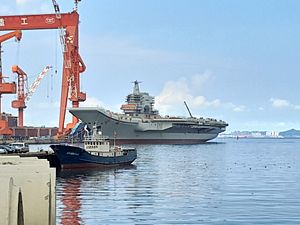The People’s Liberation Army Navy’s (PLA Navy) first domestically designed and built aircraft carrier, the Type 001A Shandong (CV-17), could take to the sea for the first time this week as final preparations for the ship’s sea trials are underway at the at the Dalian Shipbuilding Industry Company (DSIC) shipyard in China’s Liaoning Province.
A source revealed that the carrier recently conducted a main engine run indicating that sea trials were about to start, the South China Morning Post reports. Initial reports that the carrier would take to the sea already on April 23 to coincide with the PLA Navy’s 69th anniversary, however, proved incorrect. The Liaoning Maritime Safety Administration announced on April 20 that it requested three areas in the northeastern Bohai and Yellow Sea to be cordoned off for PLA Navy activities from April 20 to 28 pointing to the possibility of sea trials later this week.
As I reported in January, there had been speculation that the Shandong’s first set of sea trials will take place in mid-February around the annual Spring Festival or Chinese New Year. Sea trials will test the carrier’s overall seaworthiness including its speed, maneuverability, and equipment such as radar and communications systems, as well as safety features. As I wrote earlier this month:
The 65,ooo-ton Type 001A carrier was launched at the DSIC shipyard in April 2017. The warship is an improved variant of the PLAN’s only operational aircraft carrier, the 60,000-ton Type 001 Liaoning — a retrofitted Soviet-era Admiral Kuznetsov-class multi-role aircraft carrier. (The Liaoning and its escort ships entered Taiwan’s air defense identification zone last month during a naval training exercise.)
The Shandong has been fitted with a so-called ski-jump assisted Short Take-Off But Arrested Recovery (STOBAR) launch system also installed aboard the Liaoning. STOBAR-launched aircraft have a more limited operational range and carry lighter payloads than fighter jets launched from so-called Catapult-Assisted Take-Off But Arrested Recovery (CATOBAR) systems used on U.S. Navy carriers. (STOBAR systems put a lot of strain on the airframe of fighter jets during take-off.)
The Shandong will be able to carry up to 24 Shenyang J-15 multirole fighter jets, a variant of the fourth-generation Sukhoi Su-33 twin-engines air superiority fighter, as well as around ten rotary wing aircraft including Changshe Z-18, Ka-31, or Harbin Z-9 helicopters.
The sea trials of the Shandong are expected to take six to 12 months. Once commissioned, the carrier is expected to serve in the PLA Navy’s North Sea Fleet or East Sea Fleet. China reportedly began construction of a third carrier, designated Type 002, at a Shanghai shipyard in 2017. The new carrier will purportedly be equipped with a conventionally-powered catapult assisted take-off but arrested recovery (CATOBAR) aircraft launch system similar to the U.S. Navy’s electromagnetic aircraft launch system (EMALS) featured on the new Gerald R. Ford-class of supercarriers.

































